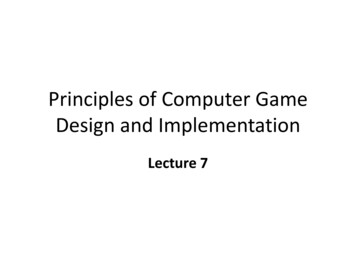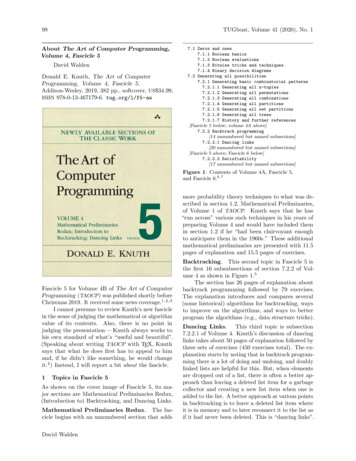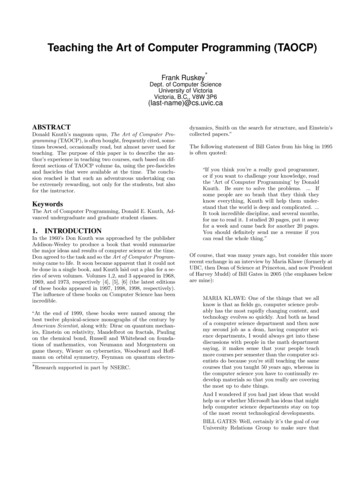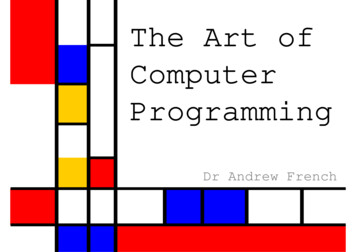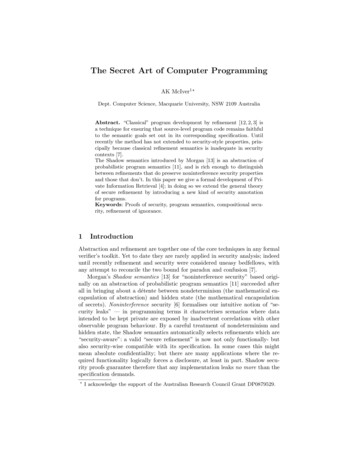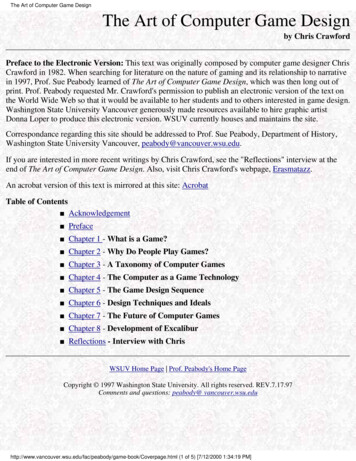
Transcription
The Art of Computer Game DesignThe Art of Computer Game Designby Chris CrawfordPreface to the Electronic Version: This text was originally composed by computer game designer ChrisCrawford in 1982. When searching for literature on the nature of gaming and its relationship to narrativein 1997, Prof. Sue Peabody learned of The Art of Computer Game Design, which was then long out ofprint. Prof. Peabody requested Mr. Crawford's permission to publish an electronic version of the text onthe World Wide Web so that it would be available to her students and to others interested in game design.Washington State University Vancouver generously made resources available to hire graphic artistDonna Loper to produce this electronic version. WSUV currently houses and maintains the site.Correspondance regarding this site should be addressed to Prof. Sue Peabody, Department of History,Washington State University Vancouver, peabody@vancouver.wsu.edu.If you are interested in more recent writings by Chris Crawford, see the "Reflections" interview at theend of The Art of Computer Game Design. Also, visit Chris Crawford's webpage, Erasmatazz.An acrobat version of this text is mirrored at this site: AcrobatTable of Contents Acknowledgement Preface Chapter 1 - What is a Game? Chapter 2 - Why Do People Play Games? Chapter 3 - A Taxonomy of Computer Games Chapter 4 - The Computer as a Game Technology Chapter 5 - The Game Design Sequence Chapter 6 - Design Techniques and Ideals Chapter 7 - The Future of Computer Games Chapter 8 - Development of Excalibur Reflections - Interview with ChrisWSUV Home Page Prof. Peabody's Home PageCopyright 1997 Washington State University. All rights reserved. REV.7.17.97Comments and questions: peabody@ peabody/game-book/Coverpage.html (1 of 5) [7/12/2000 1:34:19 PM]
The Art of Computer Game DesignACKNOWLEDGMENTI am deeply indebted to Madeleine M. Gross for her painstaking and thorough criticisms of thisbook. In many cases she invested greater efforts into her criticisms than I had put into my originalthoughts. She strove to restrain my wild hyperbole and place my arguments on a firmer foundationof rigorous logic. The logical consistency and reliability in this book I owe to her; the speculativeflights of fancy must be laid at my doorstep.TopPREFACEThe central premise of this book is that computer games constitute a new and as yet poorlydeveloped art form that holds great promise for both designers and players.This premise may seem laughable or flippant. How could anybody classify the likes of SPACEINVADERS and PAC MAN as art? How can TEMPEST or MISSILE COMMAND compare withBeethoven’s Fifth Symphony, Michelangelo’s Pieta, or Hemingway’s A Farewell To Arms?Computer games are too trivial, too frivolous to be called art. They are idle recreation at best. Sosays the skeptic.But we cannot relegate computer games to the cesspit of pop culture solely on the evidence of thecurrent crop of games. The industry is too young and the situation is too dynamic for us to dismisscomputer games so easily. We must consider the potential, not the actuality. We must address thefundamental aspects of computer games to achieve a conclusion that will withstand the ravages oftime and change.There are many definitions of art, few of which make much senseto the uninitiated. I will present my own pedestrian definition: artis something designed to evoke emotion through fantasy. Theartist presents his audience with a set of sensory experiences thatstimulates commonly shared fantasies, and so generates emotions.Art is made possible only by the richness of the fantasy world weshare. Art is nevertheless difficult, because there are so manypractical problems associated with stimulating fantasies deep inside another person’s mind. k/Coverpage.html (2 of 5) [7/12/2000 1:34:19 PM]
The Art of Computer Game Designmajor problem is getting the attention or participation of the audience. Most art allows very littleparticipation. You sit quietly and listen to music that other people created and perform, or youstroll through a museum and stare at pictures or statues other people made. You sit passively andread a novel, or a poem, or a short story. With all of these art forms, the role of the audience ispassive. The artist does all the active work, makes the biggest emotional investment. The audienceis expected to absorb quietly the fruits of the artist’s exertions. Active participation is severelycurtailed. Without participation, attention dwindles and impact crumbles away.This is in no wise a criticism of art or artists. The technologies of art preclude participation. If wehad every klutz jump into the orchestra pit, or prance on the opera stage, or slop paint withPicasso, we would have some great parties but no art. it seems the curse of art that artists can sayso much in their work and most people will hear so little because they cannot participate in the art.Enter the computer. Conceived long ago, born in war, reared as the servant of business, this nowadolescent technology has exploded out of the computer room and invaded shopping centers, pizzaparlors, and homes. Popular characterizations of the computer alternate between the old image ofthe computer as omniscient, cold blooded, giant calculator, and the new image of the computer aspurveyor of video thrills and 25 cent fixes. Originally developed as a number cruncher, thecomputer assumed a new personality when it was given graphics and sound capabilities. Thesecapabilities gave the computer a powerful asset: it could now communicate with the human, notjust in the cold and distant language of digits, but in the emotionally immediate and compellinglanguage of images and sounds. With this capability came a new, previously undreamed ofpossibility: the possibility of using the computer as a medium for emotional communication art.The computer game has emerged as the prime vehicle for this medium. The computer game is anart form because it presents its audience with fantasy experiences that stimulate emotion.Unfortunately, the current generation of microcomputers cannot produce a sensory experience asrich as that produced by, say, a symphony orchestra or a movie. This weakness is more than offsetby a fundamental advantage lacking in most other art forms: a game is intrinsically participatory innature. The artist has here a tool that is more subtly indirect than traditional art. With other artforms, the artist directly creates the experience that the audience will encounter. Since thisexperience is carefully planned and executed, the audience must somehow be prevented fromdisturbing it; hence, non participation. With a game, the artist creates not the experience itself butthe conditions and rules under which the audience will create its own individualized experience.The demand on the artist is greater, for s/he must plan the experience indirectly, taking intoaccount the probable and possible actions and reactions of the audience. The return is far greater,for participation increases attention and heightens the intensity of the experience. When wepassively observe someone else’s artistic presentation, we derive some emotional benefit, butwhen we actively participate in a game, we invest a portion of our own ego into the fantasy worldof the game. This more sizable investment of participation yields a commensurately greater returnof emotional satisfaction. Indeed, the role of participation is so important that many people derivegreater satisfaction from participating in an amateur artistic effort than from observing aprofessional effort. Hence, games, being intrinsically participatory, present the artist with afantastic opportunity for reaching people.Until now, games in general and computer games in particular have not been very impressive asart forms. The computer games especially are downright puerile. This is because the technology ok/Coverpage.html (3 of 5) [7/12/2000 1:34:19 PM]
The Art of Computer Game Designcomputer games has been in the hands of technologists, not artists. These guys (and they arealmost all male) can write beautiful operating systems, languages, linking loaders, and othertechnological wonders, but artistic flair has heretofore been treated as subordinate to technicalprowess.Another contributor to the fecklessness of our current computer games is the timidity of themarketplace. These machines are new; the public is unfamiliar with them and the manufacturersare hesitant to press the public too hard too fast. We therefore opt to build inhibited little gamespathetically whispering some trivial emotion. Truly intense emotions or situations such as pathos,ecstasy, majesty, rapture, catharsis, or tragedy intimidate use. We hide behind the defense that weare in the entertainment business, not the art business, but that defense only betrays a profoundmisunderstanding of art. Art can be starchily elitist, but good art can also be a foot stomping blast.Elitism arises from the intellectual content of art; impact springs from its emotional honesty.Fortunately, times are changing. Already, we see a backlash developing against computer games.It expresses itself in many ways: in ordinances against the placement of arcade games in someareas, in statements by educators denouncing the games, and in more vigilant regulation ofchildren’s game activities by parents. This backlash is viewed by smaller minded members of theindustry with anxiety. More visionary thinkers watch the backlash with eager interest rather thandefensiveness. The American people are telling us something here, something very important. It isimporant enough to them that they are willing to compromise their traditional reluctance tointerfere with other people’s business. While the arguments presented in public debates normallyfocus on formal issues such as delinquency from school, creation of large groups of rowdyteenagers, and so forth, the concerns expressed privately reflect a distaste for the games, a vaguesuspicion that the games are a waste of time. You can’t fool all of the people all of the time; theyare beginning to realize that the world of computer games is as yet a vast wasteland.Computer games are much like candy, comic books, and cartoons. All four activities provideintense or exaggerated experiences. Whether they use sugar, exclamation points, or animatedexplosions, the goal is the same: to provide extreme experiences. Children appreciate theseactivities because their novelty value is still strong. Adults, jaded by years of experience with suchthings, prefer diversions with greater subtlety and depth. We thus have the panoply of culinaryachievement, the vast array of literature, and the universe of movies as the adult counterparts tocandy, comic books, and cartoons. Yet, we have no adult counterpart to computer games. Thisdeficit is pregnant with possibilities, for it suggests a momentous upheaval in computer gamedesign.This developing revolution has nothing to do with the rapid technological developments of the lastfew years. While technological improvements will surely continue, we are no longer hamperedprimarily by the limitations of the hardware. Our primary problem is that we have little theory onwhich to base our efforts. We don’t really know what a game is, or why people play games, orwhat makes a game great. Real art through computer games is achievable, but it will never beachieved so long as we have no path to understanding. We need to establish our principles ofaesthetics, a framework for criticism, and a model for development. New and better hardware willimprove our games, but it will not guarantee our artistic success any more than the development oforchestras guaranteed the appearance of Beethoven. We are a long way from a computer gamecomparable to a Shakespeare play, a Tchaikowsky symphony, or a Van Gogh self portrait. Each ok/Coverpage.html (4 of 5) [7/12/2000 1:34:19 PM]
The Art of Computer Game Designthese artists stood on the shoulders of earlier artists who plunged into an unexplored world andmapped out its territories so that later artists could build on their work and achieve greater things.We computer game designers must put our shoulders together so that our successors may stand ontop of them. This book is my contribution to that enterprise.TopTop Table of Contents Chapters: 1 - 2 - 3 - 4 - 5 - 6 - 7 - 8WSUV Home Page Prof. Peabody's Home PageCopyright 1996-7 Washington State University. All rights reserved. REV.5.27.97Comments and questions: peabody@ peabody/game-book/Coverpage.html (5 of 5) [7/12/2000 1:34:19 PM]
The Art of Computer Game Design - Chapter 1What is a Game ?Chapter OneBOARD GAMESCARD GAMESATHLETIC GAMESCHILDREN’S GAMESCOMPUTER GAMESREPRESENTATIONINTERACTIONCONFLICTSAFETYIf we desire to understand games and game design, we must first clearly establish our fundamentalorientation. We must define what we mean by the word “game.” We must also determine the fundamentalcharacteristics of all games. After discussing some of the obstacles inherent in this effort, I will brieflydescribe the salient classes of games; then I will propose a set of attributes that characterize all games.Games are a fundamental part of human existence. The parlance of games has insinuated itself into ourlanguage to refer to activities that are not truly games. We play along with activities we find distasteful. Weplay ball with those who require our cooperation. We play games when we are insincere. A willingparticipant is game for the enterprise. This broad penetration of gaming concepts into the entire spectrum ofhuman experience presents us with two potential barriers to understanding games.First, our liberal use of gaming terms promotes an exaggera
The central premise of this book is that computer games constitute a new and as yet poorly developed art form that holds great promise for both designers and players. This premise may seem laughable or flippant. How could anybody classify the likes of SPACE INVADERS and PAC MAN as art? How can TEMPEST or MISSILE COMMAND compare with Beethoven’s Fifth Symphony, Michelangelo’s Pieta, File Size: 698KBPage Count: 89

